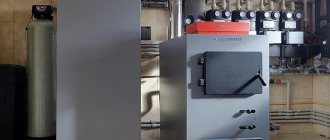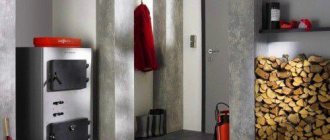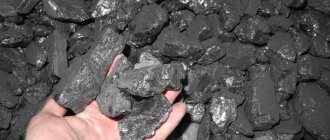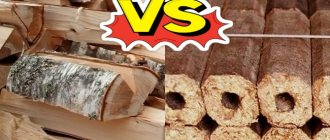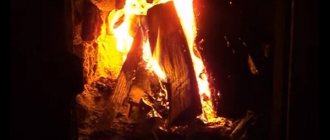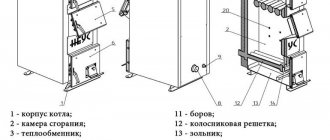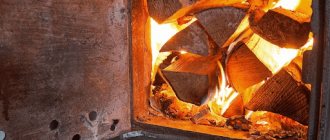Firewood and wood are in 1st place. At the beginning of the conversation, we ask customers who purchase a solid fuel boiler, what exactly do you plan to heat your premises with? About 80% answer - firewood. Yes, Belarusians heat their boilers with wood, not coal, not briquettes, not pellets. But firewood is different from firewood. What kind of firewood do you prefer to fire your boiler? What kind of firewood is good for us and what kind of wood does your solid fuel boiler like? What characteristics should they have? How many do you need? We will try to answer these and many other questions in this article.
When choosing and buying a boiler, just imagine how many fires you need to light, how many times a day you need to throw them, how often you will clean the boiler and chimney. Therefore, choosing the type of boiler and buying a boiler with optimal characteristics at the best price is a very difficult task. A good solid fuel boiler should save wood, time, and money on maintenance.
The main requirement for firewood for heating a house in general and for a modern solid fuel boiler is the longest possible burning of solid fuel and maximum heat transfer to the premises. It must be taken into account that each type of wood has its own unique characteristics, so some types are suitable for the construction of buildings, furniture, flooring, and some for fireboxes. The main characteristic for the purpose of heating a private house is the density of the wood structure: the denser the structure, the longer the wood will burn and then smolder in the combustion chamber of the boiler, giving off heat. But such firewood is difficult to light, so it is better to start kindling with looser varieties. One of the fundamental characteristics of suitable firewood is the amount of smoke and ash released during combustion.
So, let’s first look at what solid fuel boilers prefer by breed:
Bestseller!
Solid fuel boiler Defro KDR 35 kW
Long-burning floor-standing boiler with a longer firebox and manual fuel supply. Efficiency 81%. Automation S3P with PID function (OPTIONAL). Heat-resistant boiler steel P265GH 6 mm thick. Includes mechanical regulator RT-4. Power 35 kW. Reviews (2)
RUB 6,145 Buy
Bestseller!
Firewood for the fireplace
Homeowners often have the question of what kind of wood to use for burning a fireplace. Which ones heat better?
Here it is worth clarifying that the main difference between a fireplace and a stove and a solid fuel boiler is the presence of an open firebox. True, there are fireplaces that are closed with a door equipped with heat-resistant glass.
Experts offer some advice:
- It is better not to use resinous wood to light fireplaces with open fireboxes. These logs can shoot particles of heat, which often fly quite far and, otherwise, cause a fire.
- Firewood with a high moisture content should not be used, no matter how much you would like to. You can’t get heat from them, but there’s a lot of soot. Soot will be deposited on the panoramic glass of the closed combustion chamber and will deprive the owner of the opportunity to observe the flame. And the fire from wet logs will be dim and very weak.
- Soot from damp firewood remains on the walls of chimney pipes. After some time, when you load high quality fuel into the fireplace, the soot can ignite and increase the temperature in the chimney to 800 ° C, which can cause a fire.
Firewood made from alder, maple and aspen
We can conclude that you can burn a fireplace with different types of wood. The exception is resinous (including conifers). But it doesn’t make sense to use very hot logs, since the fireplace is a low-efficiency heater. The best firewood for a fireplace will be made from alder, maple, and aspen. For more fire, you can add birch or acacia.
If you are the owner of a biofireplace, you can find out about fuel specifically for it here.
Solid fuel boiler MAYAK KTR-20 EKO MANUAL UNI 20 kW
Floor-standing, solid fuel, single-circuit long-burning boiler. With an open combustion chamber, with cast iron grates. Steel thickness 6 mm. Power 20 kW. Possibility of installing a pellet burner (optional). Country of origin: Ukraine. Reviews (2)
RUR 3,728 Buy
Manufacturer's products are presented at the exhibition
Bestseller!
Heat transfer of firewood
Now let’s try to figure out which firewood is better for heating and gives off the maximum amount of heat.
The specific thermal output of wood is much lower compared to hydrocarbon fuel. Let’s say that for household gas its value will be 31.8 MJ/kg, and for wood – a maximum of 17.4 MJ/kg (birch and pine). It turns out that heating the same area of a house requires, on average, a couple of times more wood. The owner will often have to visit the room in which the boiler, fireplace or stove is located. Especially during the operation of the unit in maximum combustion mode.
There are some methods for increasing the time between loadings of solid fuel:
- choose a heat generator or stove with a large combustion chamber volume;
- use firewood that gives off the maximum amount of heat.
Almost all brick stoves have a small capacity compared to solid fuel boilers, and during the heating period they require frequent addition of firewood. At the same time, the stove does not require a large amount of wood, and produces heat for a long time and with good intensity.
Burning wood in a stove
It is known that thermal output completely depends on the combustion temperature, and it varies for different wood species. A tree that gives off a lot of heat also releases more heat energy; the only problem is to use it effectively. Let’s say oak and ash give off a lot of heat; in theory, the temperature rise is 1000 °C. Poplar burns at a maximum temperature of 500 °C.
From the table below, which examines the heat output and combustion temperature of different tree species, you can figure out for yourself which wood is best to burn.
| Breed | Heat output, % (100% maximum) | Temperature, °C |
| Beech, ash | 87 | 1044 |
| Hornbeam | 85 | 1020 |
| Winter oak | 75 | 900 |
| Larch | 72 | 865 |
| Summer oak | 70 | 840 |
| Birch | 68 | 816 |
| Fir | 63 | 756 |
| Acacia | 59 | 708 |
| Linden | 55 | 660 |
| Pine | 52 | 624 |
| Aspen | 51 | 612 |
| Alder | 46 | 552 |
| Poplar | 39 | 468 |
This table shows the combustion temperature in theory, which is achieved under the best conditions. In reality, the temperature is much lower, but the ratio is similar.
Heating a stove with oak or ash is considered a luxury, since these types of wood are very valuable and are used in the production of furniture, doors and other useful things. More affordable fuel (for the northern regions and the middle zone) is birch and white acacia (for the southern regions). Less productive in this parameter together with poplar are alder firewood and willow.
Of course, every property owner uses for kindling the type of fuel that suits him and is easiest to obtain. Coniferous wood, birch and aspen are popular. In the southern territories there are poplar and acacia.
Even firewood, characterized by the highest heat output, may not please you with its heat output if it is wet.
This characteristic greatly affects the heat transfer of the floor; see for yourself by looking at the table.
| Properties of firewood at different humidity levels | ||||||
| Wood type | Pine | Birch | Spruce | Aspen | Alder | Ash |
| Calorific value of freshly cut wood (average humidity – 50%), kW/m³ | 1900 | 2371 | 1667 | 1835 | 1972 | 2550 |
| Calorific value of semi-dry firewood (average humidity 30%), kW/m³ | 2071 | 2579 | 1817 | 1995 | 2148 | 2774 |
| Calorific value of wood stored under a canopy for at least 1 year (average humidity 20%), kW/m³ | 2166 | 2716 | 1902 | 2117 | 2244 | 2907 |
You should not expect much heat transfer from wood with a high moisture content, since most of the heat is immediately lost to the evaporation of water. Therefore, it is recommended to dry freshly cut wood. Only in this case will you be able to obtain the maximum amount of heat and achieve rational fuel consumption.
OAK
Oak firewood is the most ideal option for a boiler. Wood burns for a long time and produces the greatest amount of heat. But they are also the most expensive. It is also quite difficult to chop them into the necessary parts, and when igniting, oak firewood is difficult to ignite. But due to their high cost, you can add several logs to another type of fuel when burning in the firebox. When choosing such firewood, you should choose middle-aged oak. Our ancestors said: “There is a withered oak tree, the devil sits in it; whoever approaches will not leave”
Characteristics of firewood as fuel
Heating with wood in a private home has a number of advantages that are difficult to underestimate. And the most important advantage is its low cost. If you close your eyes to the price of natural gas for Russian residents, then wood and wood waste will absolutely take first place by this criterion. In addition, it is worth remembering that some of the settlements and houses in Russia do not have gas supply.
The undoubted advantage of heating with wood is its environmental friendliness and the feeling of comfort that it creates, emitting a pleasant aroma from fresh and burned wood. The owner has the opportunity to observe the flames in the fireplace or stove with a transparent panoramic screen that is built into the loading door.
Firewood for heating is inexpensive, but the owner will have to pay for it with personal time and physical labor.
And the main disadvantage lies precisely in this: you will have to work hard and prepare solid fuel, light the stove or boiler, maintain their operation by adding logs in a timely manner. In the case of only stove heating, it is difficult to heat remote rooms; in any case, it is necessary to use batteries. Installing a wood-burning boiler is not a cheap procedure, since it requires proper wiring and installation of additional devices.
If you need to install batteries for your furnace, you can choose suitable radiators directly from us.
Firewood for the stove
Now let's look at the following:
- how to properly heat a stove with wood;
- what kind of wood is best to heat the stove in the house.
Properly caring for your stove is not an easy task. Firstly, you need to monitor the general condition of the stove: there should be no cracks in the brickwork, and there should be no burns in the metal body that could allow smoke to pass through. Secondly, it is worth checking the draft all the time before firing, and in solid fuel boilers, inspect the loading door for complete fit.
The oven is heated like this:
- Crumpled paper, small wood chips and small logs for the stove are placed on the grates.
- The ash pan door opens a quarter, the chimney valve opens halfway.
- Ignition of paper is carried out with matches without the use of various types of liquid fuel. After the flame becomes larger, it is necessary to add more air by opening the ash pan more.
- When the fire completely engulfs the filling, you can add more wood and adjust the air supply for greater combustion.
- You need to make sure that the room is not very hot and has a comfortable temperature.
Brick dacha stoves will last longer if you do not cause the firebox to constantly overheat. Ideally, choose the medium or minimum mode if the oven is already well heated.
As for metal heaters for a private home, they can easily be heated to the maximum level. This will allow you to heat the room in a short time, and after the need for heat disappears, you can simply maintain the heating. Of course, you will have to add a small amount of logs from time to time; a large stack is only appropriate for the night.
Firewood for the stove
You should remember about timely cleaning of the ash pan, which must be carried out if necessary. But the need may be different, because you can use dry pine for the stove, and then the waste will be minimal, or you can put low-quality logs with high ash content in the firebox or add coal.
Below is a video on how to properly heat a stove with wood.
A wood-burning boiler for heating a house operates most efficiently in the “maximum” mode. Its main advantage in comparison with stoves is its high efficiency, but you must know how to use it. In this regard, professionals recommend installing a boiler for heating a private house using wood together with a buffer tank - a heat accumulator. This method is the most rational and makes it possible to take the maximum amount of energy from wood and use it to heat the room.


